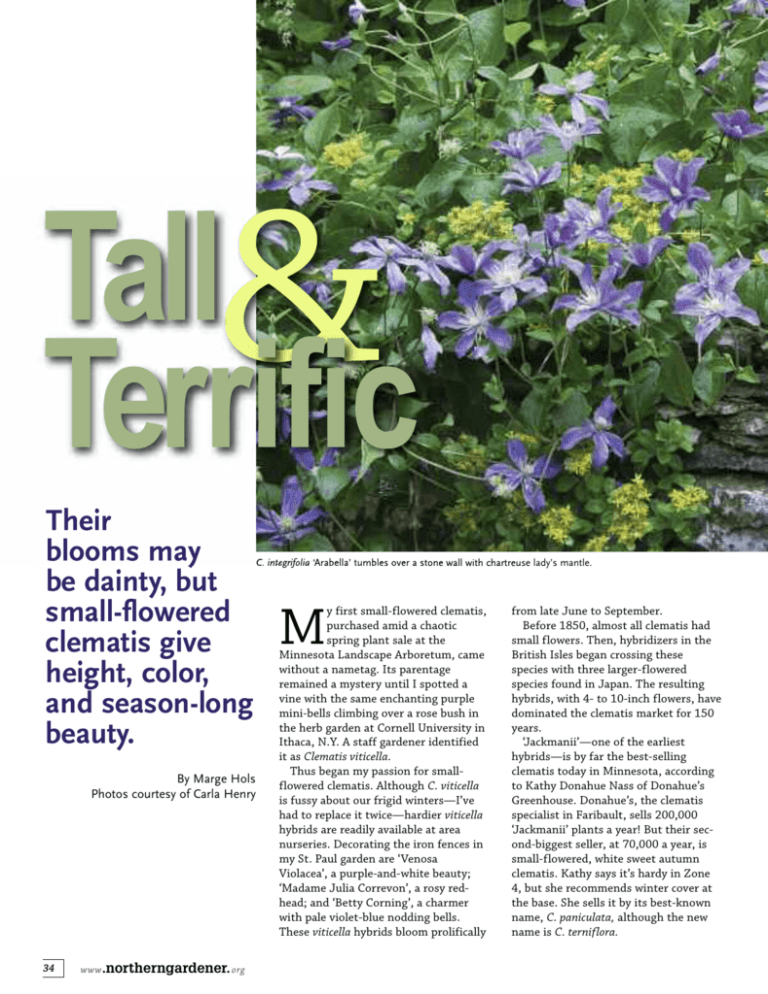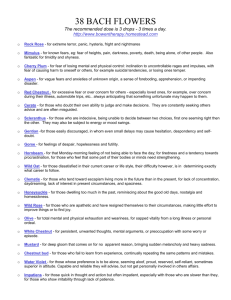Their blooms may be dainty, but small
advertisement

Tall& Terrific Their blooms may be dainty, but small-flowered clematis give height, color, and season-long beauty. By Marge Hols Photos courtesy of Carla Henry 34 www .northerngardener. org C. integrifolia ‘Arabella’ tumbles over a stone wall with chartreuse lady’s mantle. y first small-flowered clematis, purchased amid a chaotic spring plant sale at the Minnesota Landscape Arboretum, came without a nametag. Its parentage remained a mystery until I spotted a vine with the same enchanting purple mini-bells climbing over a rose bush in the herb garden at Cornell University in Ithaca, N.Y. A staff gardener identified it as Clematis viticella. Thus began my passion for smallflowered clematis. Although C. viticella is fussy about our frigid winters—I’ve had to replace it twice—hardier viticella hybrids are readily available at area nurseries. Decorating the iron fences in my St. Paul garden are ‘Venosa Violacea’, a purple-and-white beauty; ‘Madame Julia Correvon’, a rosy redhead; and ‘Betty Corning’, a charmer with pale violet-blue nodding bells. These viticella hybrids bloom prolifically M from late June to September. Before 1850, almost all clematis had small flowers. Then, hybridizers in the British Isles began crossing these species with three larger-flowered species found in Japan. The resulting hybrids, with 4- to 10-inch flowers, have dominated the clematis market for 150 years. ‘Jackmanii’—one of the earliest hybrids—is by far the best-selling clematis today in Minnesota, according to Kathy Donahue Nass of Donahue’s Greenhouse. Donahue’s, the clematis specialist in Faribault, sells 200,000 ‘Jackmanii’ plants a year! But their second-biggest seller, at 70,000 a year, is small-flowered, white sweet autumn clematis. Kathy says it’s hardy in Zone 4, but she recommends winter cover at the base. She sells it by its best-known name, C. paniculata, although the new name is C. terniflora. The many colors and shapes of small-flowered clematis: C. ‘Roguchi’ (above), C. viticella ‘Madame Julia Correvon’ (top right), and C. viorna (lower right). Rainbows of Bloom I wasn’t sure how many small-flowered clematis I’d find last spring when I called gardening friends seeking plants to photograph for this article. What my friend Carla Henry (whose stunning photos illuminate this article) and I discovered is a treasure trove of more than 20 beauties. The entire rainbow of colors is represented: white and cream, red and pink, yellow, blue, and purple, as well as delightful bicolors. With a little planning, gardeners can get spring-to-fall bloom from small-flowered clematis. Carla took the first photo, purple-white, urn-shaped Clematis fremontii, in her White Bear garden on May 2. She photographed one of the last bloomers, C. heracleifolia var. davidiana, in Shari Wilsey’s St. Paul garden on Sept. 8. This robust, bushy, non-climbing variety has showy hyacinth-type clusters of lavender flowers. “We found so many ways to present small-flowered clematis in a garden,” Carla says. “They look wonderful in an elegant formal garden, but are equally at home in a rustic setting. You can grow the clinging types up a wall or trellis, over an arch, along a fence or even through a rose bush. The bush types, like my white Clematis recta, can be grown on a support or planted so they cascade over a retaining wall.” Giving the Garden a Lift Most of the gardeners we visited said they grew clematis to gain height—the critical third dimension in a garden. “Our house is tall and clematis cover vertical space,” says Katherine Johnson, who has created a luminous white garden in St. Paul’s Highland Park. Her husband, Don, built tall, narrow, ladderlike cedar trellises and an arbor to support the vines. At a southwest corner of the house, May/June 2010 35 Tall & Terrific Clematis Care Hardiness: Many small-flowered clematis varieties are hardy to USDA Zone 4, and some are hardy to zone 3. Most clematis benefit from winter mulch. Bloom time: You can find varieties that bloom in spring, summer, or fall. Smallflowered clematis generally bloom for at least two months. Light: Clematis vines grow best with their tops in full sun (at least six hours) and roots in the shade. Small-flowered clematis tolerate a little more shade. Soil: Clematis like cool, moist, but welldrained soil. Kathy Donahue Nass recommends adding peat moss if you need to improve drainage. How to plant: Clematis grow large root systems so dig a big hole, 18 inches wide and deep. Amend the soil. Plant so the top of the root ball is 2 inches below the soil surface. Support tender new growth with stakes slanting up to the support. Mulch or plant a groundcover to shade the roots. How to support: Vining clematis climb by tendrils, so give them something to catch onto: a fence, arbor, trellis, or shrub. Bush clematis varieties don’t cling, so support them with stakes or hoops, or tie them to a fence or trellis. When to prune: Most small-flowered clematis flower on new growth in summer or fall and are classified as pruning Type 3. In early spring, cut vines back hard to a pair of healthy leaf buds about 6 inches above the soil line. Type 3 clematis include: heracleifolia, integrifolia, recta, tangutica, texensis, and viticella. A few clematis varieties bloom on the previous year’s growth in spring. Prune these Type 1 vines right after flowering by removing dead and weak stems. Included are alpina, macropetala, and montana. Clematis wilt: Most small-flowered varieties are resistant to this fungal disease, especially the integrifolia, texensis, and viticella varieties. Some large-flowered types are susceptible. Leaves turn crispy brown, usually quite suddenly. Prune back all damaged foliage and apply an all-purpose fungicide as both a foliar spray and soil drench. Treat again the following spring. Insects and critters: Clematis usually aren’t bothered by insects. Rabbits may nip off old stems near ground level in winter or new stems in spring, so protect the lower parts of vines with chicken wire. —M.H. 36 www .northerngardener. org Clematis add a striking vertical element. Here C. ternifolia (formerly C. paniculata) covers an archway. starting in late June, two vigorous clematis vines intertwine. ‘Huldine’ blankets its trellis with 3-inch, pearly white flowers with lemon centers, which complement the smaller white flowers of C. viticella ‘Alba Luxurians’. In September, sweet autumn clematis crowns the garden arbor. Pat Vincent grows Clematis virginiana in her White Bear garden. This native looks like sweet autumn clematis, but it’s hardier and blooms earlier—mid into late summer. Pat has tamed the vine’s somewhat rambunctious habit by threading its long tendrils along the top of an unpainted picket fence. Clematis vines reign in Kathleen Corrigan’s charming cottage garden in Highland Park. A dozen large-flowered varieties climb a lattice-topped cedar fence. Deep purple ‘Polish Spirit’, a viticella hybrid, mingles with wisteria on a backyard pergola. But it’s two diminutive clematis hybrids in her front garden that Kathleen was most enthusiastic about. She urged us to look closely at ‘Roguchi’, a bushtype, non-clinging integrifolia hybrid she trained to an iron trellis. The buds are almost black, she said, but by peak bloom the ribbed, bell-shaped flowers turn to two shades of purple. She also showed us the pale violet-blue bells of ‘Betty Corning’, which dance about a coppertopped fence post. (Sadly, Kathleen, a long-time kindergarten teacher who took great joy in her garden and loved entertaining friends there, died in January after a long illness.) A cloud of Clematis tangutica’s bright yellow bells decorates a tall timber arch over the alley entrance to Vera Trent’s sun-filled back garden in the Merriam Park neighborhood of St. Paul. More clematis vines entwine on a rustic fence of tree branches made by Vera’s husband, James Nylund. Included is one of Vera’s favorites, C. texensis ‘Duchess of Clematis Sources You’ll find a few varieties of small-flowered clematis at most garden centers. For larger selections, try these sources: Completely Clematis, Ipswich, MA, 978-356-3197, www.clematisnursery.com. Donahue’s Greenhouse, Faribault, 507-334-7156, www.donahuesclematis.com. Retail business open through June 15. Klehm’s Song Sparrow, Avalon, WI, 800-553-3715, www.songsparrow.com. Lilydale Garden Center, West St. Paul, 651-457-6040, www.lilydalegardencenter.com. Venero Gardens, Excelsior, 952-474-8550, open by appointment, www.venerogardens.com. —M.H. Clematis flower forms provide texture to the garden: C. tangutica (above), C. heracleifolia var. davidiana (top right), C. ‘Huldine’ (lower right). Albany’, a vigorous bloomer with small, up-facing, tulip-like pink flowers. In Bonnie Blodgett’s Crocus Hill garden, I was so taken by a rose-purple viticella hybrid, ‘Purpurea Plena Elegans’, I bought one the very next day. The flowers have so many petals they look ruffled. “Because I don’t have a tall trellis for it, I let it go flying up into the air looking for something to hold onto,” Bonnie says. “Then, just before it blooms, I pull it down and wrap it around its iron trellis.” In Dick and Shirley Friberg’s Roseville garden, what captured Carla’s photographic eye on a July day was the adorable Clematis pitcheri, a small purple urn with white trim. Like Carla’s C. fremontii, it’s among the species called “leather flower” because of its thick blossoms. Carla later bought another of this group, rose-white Clematis viorna, at Venero Gardens in Excelsior. During July in Kathy Dirks’ magical hillside garden, an entire garage wall is blanketed with a breathtaking display of two viticella hybrids, purple ‘Etoile Violette’ and pale lavender-blue ‘Betty Corning’. Kathy, who gardens in St. Paul’s Shadow Falls neighborhood, also grows several cultivars of C. integrifolia. ‘Arabella’, a lavender-blue beauty with cream-colored anthers, scrambles over a stone wall in tandem with chartreuse lady’s mantle. Bell-shaped, rosy pink ‘Alionushka’ takes support from a columnar arborvitae at the edge of a path. Says Kathy, with a smile, “I love clematis—doesn’t everybody?” P.S.: According to the American Horticultural Society, the correct pronunciation is KLEM-uh-tiss, not kleeMAT-tus. Marge Hols is a garden designer, Master Gardener, and former garden columnist for the St. Paul Pioneer Press. Carla Henry is a hobby gardener and photographer living in White Bear Township. May/June 2010 37







